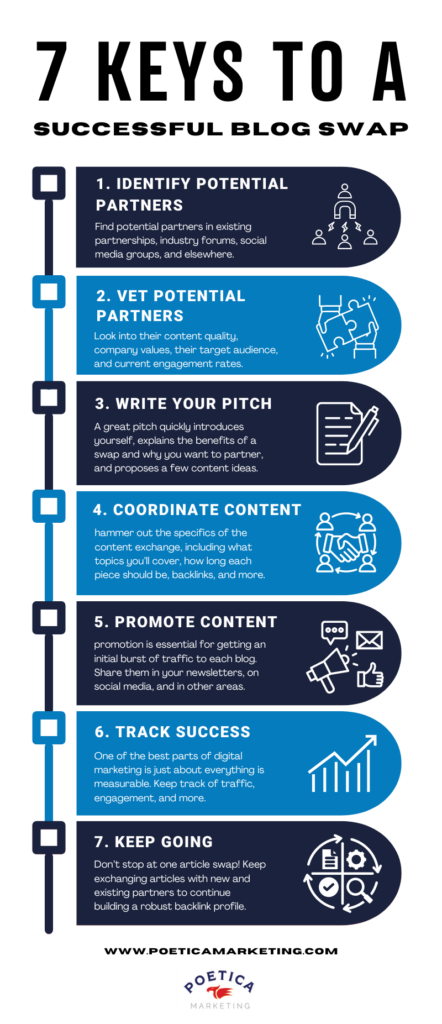How to Coordinate a Blog Swap: A Step-by-Step Strategy for SMB Owners and Busy Marketers
The digital marketing landscape has never been more challenging for marketers.
With an incredibly low cost of entry, countless techniques to try, and endless strategies for measuring success, digital marketing has exploded in popularity—and everyone is competing for success.
That’s why SEO—search engine optimization—has become such a major portion of modern marketing strategies. By consistently ranking high on the SERP (search engine results page) for common target audience queries, companies can drive more traffic to their websites.
And one of the best ways to increase your SEO performance is to earn more backlinks. And one of the best ways to increase your backlinks?
Blog swaps.
Skip to the sections most valuable to you to learn more!
Table of Contents
Understanding the Value of Blog Swaps
How to Coordinate A Blog Swap: 7 Keys to Success
Where to Learn More
Understanding the Value of Blog Swaps
Through coordinated article exchanges with trusted partners, you can:
- Increase valuable backlinks to your website
- Increase site traffic
- Increase the variety of content available through your blog
- Reach a new audience of readers
- Improve your ranking performance on search engines
None of those are anything to shrug off!
How to Coordinate A Blog Swap: 7 Keys to Success
Here’s your step-by-step guide for a successful article exchange:

1. Identify Potential Partners
Look for businesses (especially partners) that complement your business instead of directly competing with it. Ideally, they should share a similar target audience without offering the same services as you—and they should have a domain authority that is similar to or better than yours.
If you’re unfamiliar with the term, domain authority is simply a numerical representation of the amount of trust placed in your brand. You can quickly check a website’s authority with the Ahrefs Website Authority Checker.
A few strategies for finding potential partners include:
- Look through your existing partnerships for potential matches
- Network inside industry forums and social media groups where you’re already active
- Use LinkedIn to connect with other business owners and marketers
- Attend industry events for new networking opportunities and potential partnerships
2. Vet Potential Partners
Once you have your potential partners picked out, it’s time to ensure they’re a good fit.
In addition to checking their domain authority, you should also check into:
- Their content quality. Do they write well? Remember: Their content is going to wind up on your website, and you don’t want them to make an impression that could make you look bad!
- Their company values. You want your partner’s values to align with your own.
- Engagement. Do their posts matter to readers? Do readers share or comment on their content?
- Who’s their target audience? How much overlap is there between who they’re going after and who you want to do business with?
3. Write Your Pitch
The next step is to ask the site owner whether they’d like to partner with you. This is a relatively easy step if you’re working with one of your existing company partners.
But if you’re reaching out to someone new, tread carefully—or else they may become suspicious of your intentions.
A great pitch quickly introduces yourself, explains the benefits of a swap, and proposes a few content ideas.
Here are a few elements to include:
- A brief introduction of yourself and your business.
- A brief explanation of why you’re interested in working with them
- A clear explanation of the blog swap concept and its benefits (for ideas, check out our blog on How to Increase Sales With Blogging).
- A few content ideas tailored to their audience’s interests (for ideas on this one, check out our blog on 10 Quick Ways to Come Up With New Blog Topics Right Now).
- A list of SEO benefits, highlighting the mutual gain from high-value backlinks. For more, read these 9 Awesome Advantages of Content Marketing.
4. Coordinate Content
Once the partnership is established, it’s time to hammer out the specifics of the content exchange. Be sure to discuss:
- Topics you’ll cover – You should cover topics that benefit each of you.
- Content length and depth – You should each spend an equal amount of time writing and researching your content.
- The number and placement of backlinks – You should each receive an equal share of backlinks to your website. And remember to link to your most valuable or strategic pages! Pro tip: If you’d like to track how much traffic your website gets from your new article, embed your links with UTM codes. Use Google’s Campaign URL Builder for help!
- Publication date – You should know exactly when you’ll publish their content—and when they’ll publish yours.
- Promotion tactics – You should share the load when it comes to promoting through email, social media, and other channels!
5. Promote the Content
As we just mentioned, promotion is essential for getting an initial burst of traffic to each blog. Tactics to include:
- Share in your company newsletter
- Share through your company’s social media accounts
- Share through your LinkedIn account
- Share their company’s social media posts
- Share their personal LinkedIn posts
- Submit the new URL into Google Search Console to ensure it gets crawled and indexed (and be sure to check back to see if there were any issues with getting indexed)
6. Track Success
One of the best parts of digital marketing is just about everything is measurable. Keep track of:
- Traffic from your partner’s website (and especially the new article)
- Engagement on both blog posts
- Organic traffic to each blog post
- Improvements to your SEO performance
7. Keep Going!
Don’t stop at one article swap! Keep exchanging articles with new and existing partners to continue building a robust backlink profile.
Where to Learn More
To learn even more about effective article swaps, contact us! We can help you coordinate blog swaps that generate meaningful results for all parties involved!
